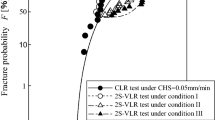Abstract
The fracture toughness of polycrystalline ceramics used to present the scale effect as well as statistical distribution. It is believed that both (scale effect and scatter) must be associated with the heterogeneity of materials. However, no generally accepted theory has been established so far. Using statistical approach, a probabilistic modelling for the fracture toughness which describes the scale effect was attempted in this paper. Weibull distribution of specific fracture energy (SFE) at local area and Griffith criterion are jointly applied to the model. Finally, the fracture toughness scale dependence of ASTM E399 standard specimens was investigated by the newly developed model.
Similar content being viewed by others
References
ASTM E399. 1992, Annual Book of ASTM Standards, Vol. 02.02.
Bao, Yiwang, Jin, Zongzhe and Li, Xiaorui, 1994, “Evaluation of KIC Depending on Sample Size for Ceramics,”Engineering Fracture Mechanics, Vol. 48, No. 1, pp. 85–90.
Calomino, A., Brewer, D., Kim, A. and Chudnovsky, A., 1992, “A Comparative Analysis of Brittle Fracture in Amorphous and Polycrystalline Materials,”Proceedings of Materials Research Society Symposium, Vol. 279, pp. 165–172.
Chudnovsky, A., Kim, A. and Bosnyak, C. P., 1992, “An Energy Analysis of Crack Initiation and Arrest in Epoxy,”Int. J. of Fracture, Vol. 55, pp. 209–222.
Chudnovsky, A., and Kunin, B., 1987, “Probabilistic Model of Brittle Crack Formation,”Journal of Applied Physics, Vol. 62, No. 10, pp. 4124–4129.
Duan, K., Mai, Y.-M. and Cotterell, B. 1995, “R-Curve Effect on Strength and Reliability of Toughened Ceramic Materials,”Journal of Materials Science, Vol. 30, pp. 1405–1408.
Frendenthal, A. M., 1968, “Statistical Approach to Brittle Fracture,”Fracture an Advanced Treatise, Vol. 2. Academic Press, pp. 591–619.
Gurumoorthy, B., Kircher, H. O. K., Prinz, F. B. and Sinclair, G. B., 1988, “Thickness Effects May Not Do What You Think Do,”Engineering Fracture Mechanics, Vol. 29, No. 6, pp. 637–640.
Matsuo, Y., Kitakami, K., and Kimura, S., 1987, “Crack Size and Strength Distribution of Structural Ceramics After Non-Destructive Inspection,”Journal of Materials Science, Vol. 22, pp. 2253–2256.
Neville, D. J., 1987, “The Non-Conservatism of the Weibull Function when Applied to the Statistics of Fracture Toughness,”Int. J. of Fracture, Vol. 34, pp. 309–315.
Author information
Authors and Affiliations
Rights and permissions
About this article
Cite this article
Kim, A., Nahm, SH. A probabilistic model for the scale effect on fracture toughness of structural ceramics. KSME International Journal 12, 792–799 (1998). https://doi.org/10.1007/BF02945546
Received:
Issue Date:
DOI: https://doi.org/10.1007/BF02945546




